Abstract on the theme of master's work
Content
- Introduction
- Goals and tasks
- Actuality
- Possible scientific novelty
- Review of researches and developments on the topic
- Own researches and planned practical results
- Conclusion
- Sources
Introduction
The history of robotics goes back to the ancient times, when for the first time appeared an idea of a device for heavy mechanical work, which was usually performed by a human. Such devices and mechanisms are mentioned in the works of Homer and Aristotle, as well as in the works of Goethe. However, all of these were just ideas, sometimes even just a fiction which was impossible to implement. Therefore, the intensive development of robotics started only in the twentieth century, when many of the ideas got an opportunity of hardware implementation [6].
Nowadays, you can find the following definition of Robotics: Robotics (from the robot and technology) - is an applied science concerned with the development of automated technical systems and is an important technical basis for the intensification of production, robotics relies on such disciplines as electronics, mechanics, informatics [15]. Such systems are called robots.
Robot - is an automatic device for implementation of the mechanical actions of the kind that does human performing physical work [18]. The constant model for the development of robots from the very beginning of development of robotics and to present day is human. Creating robots often the main task is to replace a man by developed mechanism to not only simplify the task for people, but also to maximize the quality of the work, excluding the human factor [1]. Appearance and design of modern robots can be quite diverse.
The mobile robot is one of the most important classes of robots. Feature of mobile robots is their autonomy, the ability to move independently of any external stationary devices. However, this explains one of the most important design issues of such a device - the development of a mobile robot interaction with the environment, in accordance with her function.
A robot must not only "feel" their surroundings, but also process information about it and change their behavior based on perception. Therefore robots must be provided with a specific sensor.
When you create a robot is interesting to analyze the human sensory systems as main model [19]. Man, even by the most conservative estimates at least 80% of the information gets only from the organs of sight and about 15% from hearing. Thus, we can conclude that the analysis of audio and visual information is to be a key component of in the system of robot interaction with the environment.
Goals and tasks
The work is scientific and practical, and its main purpose is to study the methods and approaches to the problem the supply a mobile robot with system of artificial intelligence based on neural networks and the use of the developed system in practice.
To achieve these objectives it is necessary to solve a number of problems:
- Research of possibilities of application of computer vision for a mobile robot.
- The research of methods to create neural networks for mobile robot control.
- Development of algorithm of operation for the mobile robot using neural networks and computer vision.
- The development of the hardware platform for experimental research.
- Carrying out tests and experiments on the designed hardware platform.
Actuality
At present, the development of robotics and artificial intelligence is actively developing, every year new models of robots of various kinds are created, various conferences and exhibitions are carried out, mobile robotic systems are used in various industries, and therefore the relevance of developments in this area every day only increases. At the same time, the area of computer vision can be described as a young, diverse and dynamic, many of the methods and applications are still in the stage of basic research.
Possible scientific novelty
Possible scientific novelty of this work is to develop an algorithm for the autonomous functioning based on neural networks and communication system with the user of the mobile robot based on the Arduino and Raspberry Pi. When designing a system functioning of robot with the environment is assumed to apply techniques of computer vision.
Review of researches and developments on the topic
Popular History of robotics leads the narration from the myth of the iron servants of Hephaestus, Mary Kelly’s "Frankenstein", through the amazing hourly mechanisms as singing bronze pheasants and entire moving cities to robots on Mars and Honda’s humanoid robot Asimo. That shows the development of the dream of robots [17].
In Ukraine, the developments in the area of artificial intelligence started to be engaged more from the mid 60-ies of XX century. There are Institute of Cybernetics (under the direction of T. Vintsyuka), the University of Lviv (P. Derkach), Kharkov State Institute of Radio Electronics (M. Bondarenko), Dnepropetrovsk University (A. Karpov), the University of Odessa (T. Brovchenko and E. Nushikyan) [16].
Among the intelligent mobile robots there are such projects as iCub (figure 1) [24], E-puck (figure 2)[25] and Spykee (figure 3) [26].
iCub - the humanoid robot, developed by a consortium of The RobotCub Project. The main scientific objectives of the study are cognitive (learning) manipulation (gestures, imitation of movements, interactions with the help of gestures), the perception of the environment, movement, associative perception of human speech. The main engineering goal was creation of advanced humanoid platform, useful for the entire scientific community.
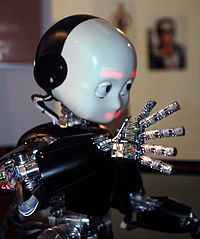
Figure 1 – Robot iCub
The e-puck is a small (7 cm) differential wheeled mobile robot. It was originally designed for micro-engineering education by Michael Bonani and Francesco Mondada at the ASL laboratory of Prof. Roland Siegwart at EPFL (Lausanne, Switzerland). The e-puck is open hardware and its onboard software is open source, and is built and sold by several companies.
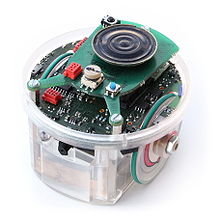
Figure 2 – Robot E-puck
Spykee, the mobile robot of Meccano, is a Wifi-robot that can be controlled remotely over the Internet, has many features, including photo and video, mp3-player, etc.
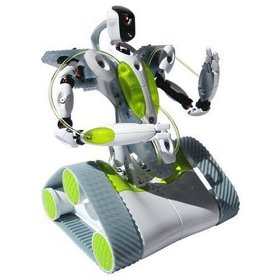
Figure 3 – Robot Spykee
Since robotics is a quite rapidly growing industry in modern times, many ways to implement the algorithms has been developed by scientists to provide the main "organ" of a mobile robot, its navigation. The most common movements of the robot movements are associated with avoiding objects for which the only restriction is that the robot must not come across with objects in the workspace.
Algorithms designed for robot obstacle avoidance in three-dimensional space can be divided into several classes: a hypothesis test, the penalty function; skeleting method, fuzzy logic [14], neural networks, genetic algorithms, algorithm based on the behavior of Mexican jumping beans, developed by researchers from the Georgia Institute of Technology (USA) [23]
Own researches and planned practical results
For the initial testing of the hardware platform simple obstacle avoidance algorithm considering hardware features was developed. The device for which the algorithm is developed in this work, is a platform on 4 wheels, equipped with five ultrasonic sensors for measuring distance, the Arduino and Raspberry Pi.
At the moment there is a huge amount of literature on the design and development of a low-cost mobile robot [11], including those based on Arduino and Raspberry Pi, a low-cost platforms that is most commonly used for such purposes.
The platform, which all the further researches and experiments will be based on, includes hardware computing platform Arduino [2]. This platform is a board that consists of microcontroller Atmel AVR, and also includes a variety of connectors for integration with other circuits. There are many different versions. This work the Arduino Mega board in 2560 was used (Figure 4).
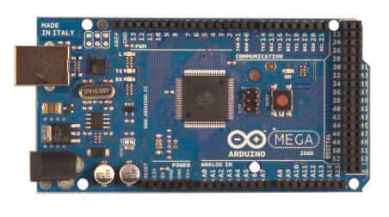
Figure 4 - Board Arduino Mega 2560
The advantage of this board over the other modifications is a lot of input-output ports, so in the future there is an opportunity to expand the number of additional sensors and option boards.
Because of the relatively weak capability Arduino to control the entire design and remote control, it was decided to use as a control board single board computer Raspberry Pi (Figure 5) [20].
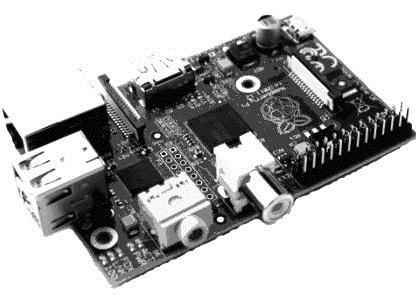
Figure 5 - Board Raspberry Pi
The frame on which boards and motors are mounted is a small metal block with four wheels (Figure 6).
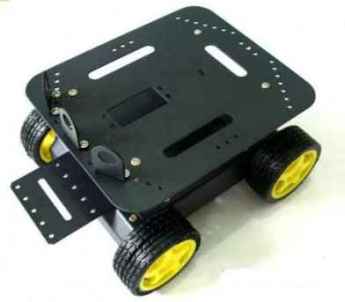
Figure 6 - Platform frame
Of the various sensors that can be connected to the Arduino, in this development an ultrasonic range finder HC-SR04 (Figure 8) is used, with which you can get information about the distance to the nearest obstacle to the robot [7]. The rest of the visual information the robot will get through a camera connected to the Raspberry Pi.
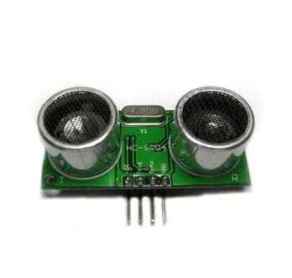
Figure 7 - Ultrasonic range finder
For connection between two boards a simple library of functions has been developed. Also, a simple logic algorithm has been developed to avoid obstacles.
This algorithm is not related to neural networks, which will be used in the future, but it is a test base for platform and allows to evaluate its hardware capabilities and the ability to learn that in the future and will be used.
Conclusion
To develop algorithm of operation for the mobile robot the theory of neural networks has been selected as the most progressive and approximate to the functioning of a living organism. For an even closer approximation to this pattern also computer vision will be used, which should provide the best possible autonomy of mobile robot in decision-making according to changes in its environment. At the moment of writing this essay master's work is not yet complete. Final completion: December 2013. Full text of the work and materials on the topic can be obtained from the author or her supervisor after that date.
Sources
- Юревич Е.И. «Основы робототехники». - 2-е изд., перераб. и доп. - Спб.: БХВ-Петербург, 2005. - 416 с.: ил.
- Board Arduino. Electronic source. Access mode: http://arduino.ru
- Конструирование роботов: Пер. с франц./ Андре П., Кофман Ж.-М., Лот Ф., Тайар Ж.-П – М.: Мир, 1986. – 360 с., ил.
- Michael McRoberts «Beginning Arduino». – 2010. – 459 с., ил.
- Motor Shield - Arduino motor. Electronic source. Access mode: http://www.ladyada.net/make/mshield/index.html
- Юревич Е.И. «Управление роботами и роботехническими системами». - 2-е изд., перераб. и доп. - Спб.: БХВ-Петербург, 2005. - 416 с.: ил.
- Куафе Ф. «Взаимодействие робота с внешней средой: Пер. с франц». – М.: Мир, 1985. – 285с.
- Шахинпур М. «Курс робототехники: Пер. с англ.» - М.: Мир, 1990. – 527с.
- Хорн Б.К.П. «Зрение роботов: Пер. с англ.» - М.: Мир, 1989. – 487с.
- Майк Предко «Устройства управления роботами: схемотехника и программирование».– М.: ДМК-Пресс, 2004. – 403с.
- Бишоп О. «Настольная книга разработчика роботов. – К.: «МК-Пресс», СПб.: «КОРОНА-ВЕК», 2010. – 400с.
- Хайкин С. Нейронные сети: полный курс, 2-е изд., испр. : Пер. с англ. – М.: ООО «И.Д.Вильямс», 2006. – 1104 с.: ил.
- Головко В.А. Нейронные сети: обучение, организация и применение. Кн.4: Учеб. пособие для вузов // Общая ред. А.И.Галушкина. – М.: ИПРЖР, 2001. – 256с.: ил.
- Круглов В.В., Борисов В.В. Искусственные нейронные сети. Теория и практика. 2-е изд. – М.: Горячая линия – Телеком, 2002. – 382 с.: ил.
- Wikipedia article «Робототехника». Electronic source. Access mode: http://ru.wikipedia.org/wiki/%D0%A0%D0%BE%D0%B1%D0%BE%D1%82%D0%BE%D1%82%D0%B5%D1%85%D0%BD%D0%B8%D0%BA%D0%B0
- Соснина А., article «Сучасний стан та перспективи розвитку робототехніки в Україні», 2013.
- Баженов С., article «Прошлое и будущее робототехники», 2012. Electronic source. Access mode: http://www.cleverence.ru/site.aspx?page=Robotics#_Toc177756979
- Wikipedia article «Робот». Electronic source. Access mode: http://ru.wikipedia.org/wiki/%D0%A0%D0%BE%D0%B1%D0%BE%D1%82
- Янг Дж.Ф. «Робототехника: Пер.с англ.» - Л.: Машиностроение. Ленингр.отд-ние, 1979. – 300с.
- Raspberry Pi. Electronic source. Access mode: http://www.raspberrypi.org/
- Килибарда Г., Кудрявцев В.Б., Ушчюмлич Ш. Независимые системы автоматов в лабиринте // Дискретная математика ? Т. 15. ? В. 3 ? 2003.
- Neural network for obstacles avoidance. Electronic source. Access mode: http://stswoon.blogspot.com/2010/05/blog-post.html
- Movements of Mexican jumping beans. Electronic source. Access mode: http://www-old.me.gatech.edu/hu/Publications/Hu12-beans.pdf
- Robot iCube. Electronic source. Access mode: http://www.icub.org/
- Robot E-puck. Electronic source. Access mode: http://www.e-puck.org/
- Robot SpyKee. Electronic source. Access mode: http://www.spykeeworld.com/
